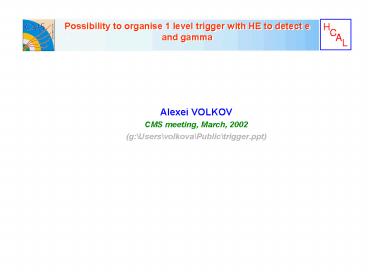Alexei VOLKOV - PowerPoint PPT Presentation
1 / 7
Title:
Alexei VOLKOV
Description:
In the first option a trigger element consists of one HE tower. ... Without EE at high luminosity HE will be damaged due to high radiation level. ... – PowerPoint PPT presentation
Number of Views:19
Avg rating:3.0/5.0
Title: Alexei VOLKOV
1
Possibility to organise 1 level trigger with HE
to detect e and gamma
- Alexei VOLKOV
- CMS meeting, March, 2002
- (g\Users\volkova\Public\trigger.ppt)
2
INTRODUCTION
- During first several years of CMS operation EE
will not be installed. - Task - to organize 1 level HE trigger for ? and e
without EE for low luminosity. - Define ET threshold for ? and e at which the
counting rate will be about 1 kHz. - HE is proposed to be segmented in longitudinal
direction into two parts. - First part has 5 layers (40 cm of brass, 28X0,
2.6 ?int) to organize 1 level trigger for ? and e.
3
SEGMENTATION of HE
Segmentation of HE for operation without EE.
4
SIMULATION
- There was developed a program for fast simulation
of nuclear and electromagnetic showers which uses
parameterization of experimental cascades
measured at different energies. - The program also uses the Pythia Monte Carlo for
simulation of a few millions QCD and low pT
events. - The program took into account the detector
geometry and charge particle passage in magnetic
field (BZ 4T).
5
TRIGGER ELEMENTS STRUCTURE
- Two options of trigger element structure were
considered. - In the first option a trigger element consists of
one HE tower. The psevdorapidity range was
1.48lt?lt2.52. In this case there is an energy
dependence of e/? efficiency detection on their
position relative to tower boundary. - In the second option a trigger element consists
of 2x2 HE towers and space dependence of
detection efficiency will be much less than in
the first option. - But in this case the trigger rate will increase.
6
RESULTS
Trigger rate is shown as a function of trigger
ET cutoff.
7
SUMMARY
The 1st level trigger for ? and e will have
acceptable rate at low luminosity (1033 cm-2s-1)
when a single HE tower is a trigger element
with threshold ETgt25 GeV and 2x2 HE towers with
threshold ETgt35 GeV. Without EE at high
luminosity HE will be damaged due to high
radiation level. For the described performance
it is necessary to calibrate the HE PPP with
electrons and hadrons for new longitudinal
division. This calibration also will allow to
obtained the necessary data for more precise
simulation of shower leakage from tower to tower.













![[1] Ivan M. Okhapkin, Elena E. Makhaeva, Alexei R. Khokhlov in press PowerPoint PPT Presentation](https://s3.amazonaws.com/images.powershow.com/A1262250906fVKXG.th0.jpg?_=20160131060)
















